Comparative Analysis of Prion Detection Technologies: A Report
VerifiedAdded on 2023/01/06
|17
|3009
|57
Report
AI Summary
This report provides a comprehensive overview of various technologies used for the detection of prions, which are misfolded proteins responsible for fatal neurodegenerative diseases like Creutzfeldt-Jakob disease (CJD). The report details five key technologies: Protein Misfolding Cyclic Amplification (PMCA), Immunohistochemical Detection, Enzyme-linked immunosorbent assay (ELISA), The Real-Time Quaking-Induced Conversion (RT-QuIC) assay, and Streptomycin detection. It explains the principles, applications, and effectiveness of each method, including their sensitivity and specificity in detecting PrPSc, the abnormal form of the prion protein. The report highlights the importance of early prion detection for improving patient outcomes and preventing the spread of prion diseases. The report also includes a table summarizing the key features of each technology and their applications in detecting prions in different tissues. The report also discusses the limitations and challenges associated with each technology. Overall, the report serves as a valuable resource for understanding the current landscape of prion detection methods.

Technologies to detect the Prion
Paraphrase This Document
Need a fresh take? Get an instant paraphrase of this document with our AI Paraphraser
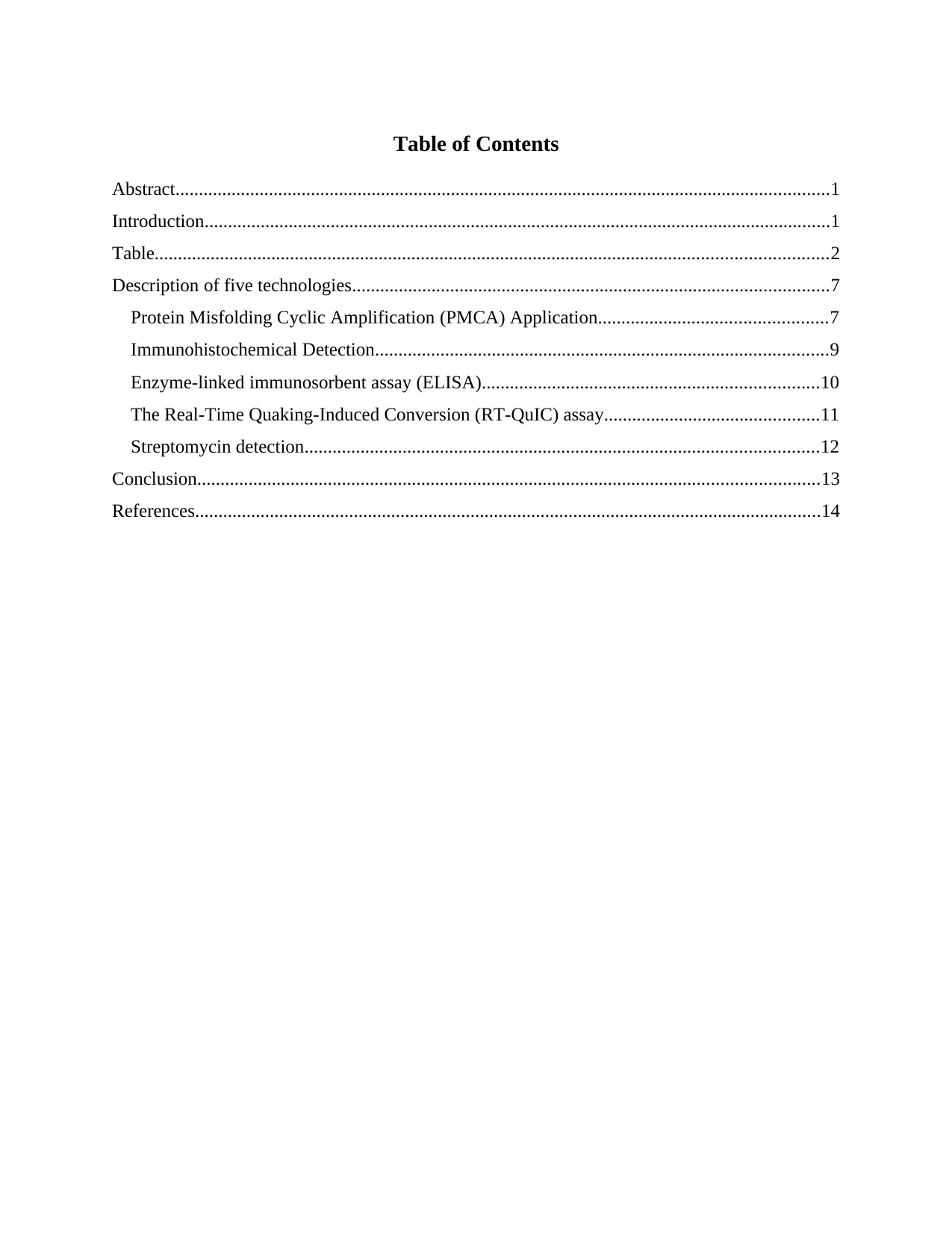
Table of Contents
Abstract............................................................................................................................................1
Introduction......................................................................................................................................1
Table................................................................................................................................................2
Description of five technologies......................................................................................................7
Protein Misfolding Cyclic Amplification (PMCA) Application.................................................7
Immunohistochemical Detection.................................................................................................9
Enzyme-linked immunosorbent assay (ELISA)........................................................................10
The Real-Time Quaking-Induced Conversion (RT-QuIC) assay..............................................11
Streptomycin detection..............................................................................................................12
Conclusion.....................................................................................................................................13
References......................................................................................................................................14
Abstract............................................................................................................................................1
Introduction......................................................................................................................................1
Table................................................................................................................................................2
Description of five technologies......................................................................................................7
Protein Misfolding Cyclic Amplification (PMCA) Application.................................................7
Immunohistochemical Detection.................................................................................................9
Enzyme-linked immunosorbent assay (ELISA)........................................................................10
The Real-Time Quaking-Induced Conversion (RT-QuIC) assay..............................................11
Streptomycin detection..............................................................................................................12
Conclusion.....................................................................................................................................13
References......................................................................................................................................14

⊘ This is a preview!⊘
Do you want full access?
Subscribe today to unlock all pages.

Trusted by 1+ million students worldwide
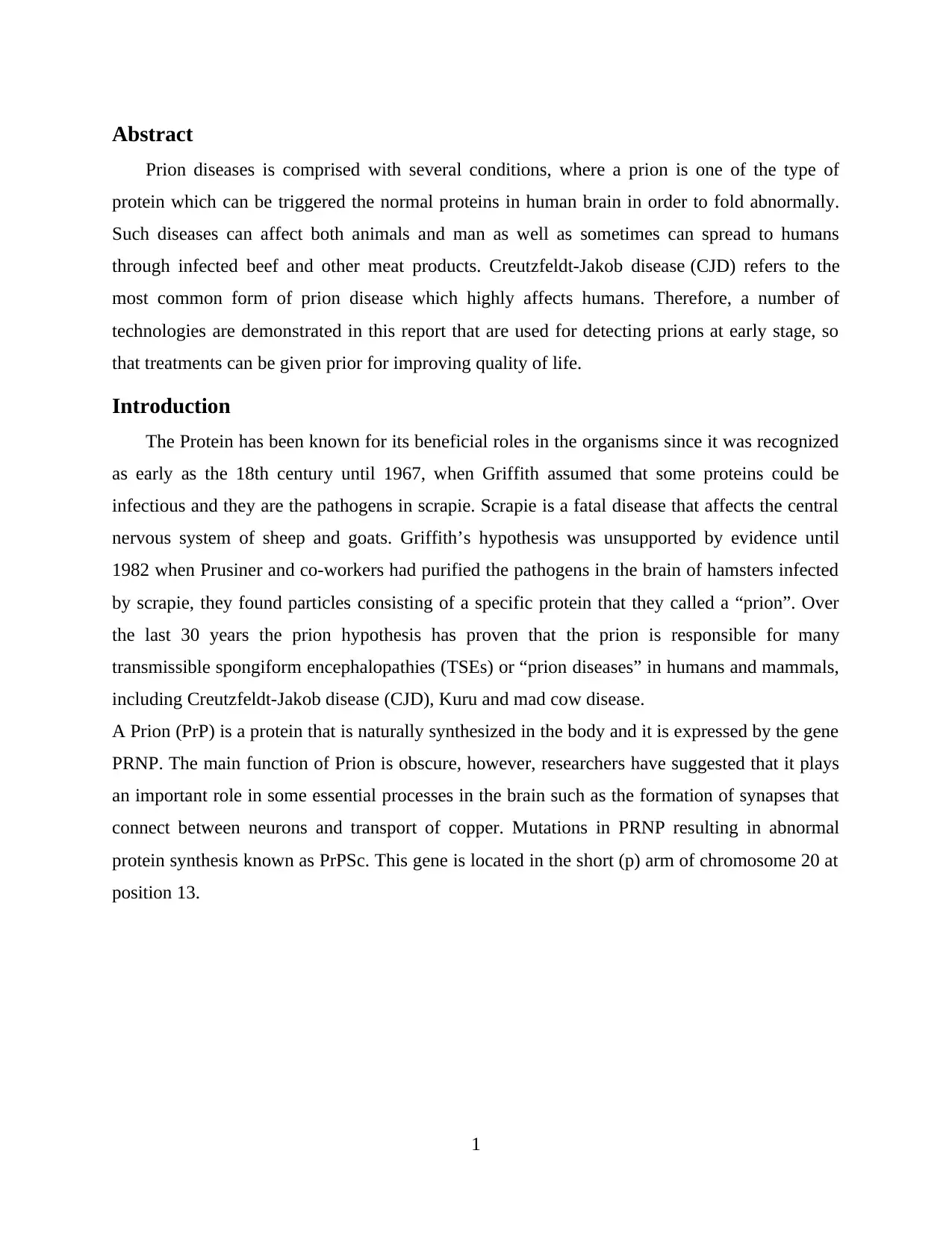
Abstract
Prion diseases is comprised with several conditions, where a prion is one of the type of
protein which can be triggered the normal proteins in human brain in order to fold abnormally.
Such diseases can affect both animals and man as well as sometimes can spread to humans
through infected beef and other meat products. Creutzfeldt-Jakob disease (CJD) refers to the
most common form of prion disease which highly affects humans. Therefore, a number of
technologies are demonstrated in this report that are used for detecting prions at early stage, so
that treatments can be given prior for improving quality of life.
Introduction
The Protein has been known for its beneficial roles in the organisms since it was recognized
as early as the 18th century until 1967, when Griffith assumed that some proteins could be
infectious and they are the pathogens in scrapie. Scrapie is a fatal disease that affects the central
nervous system of sheep and goats. Griffith’s hypothesis was unsupported by evidence until
1982 when Prusiner and co-workers had purified the pathogens in the brain of hamsters infected
by scrapie, they found particles consisting of a specific protein that they called a “prion”. Over
the last 30 years the prion hypothesis has proven that the prion is responsible for many
transmissible spongiform encephalopathies (TSEs) or “prion diseases” in humans and mammals,
including Creutzfeldt-Jakob disease (CJD), Kuru and mad cow disease.
A Prion (PrP) is a protein that is naturally synthesized in the body and it is expressed by the gene
PRNP. The main function of Prion is obscure, however, researchers have suggested that it plays
an important role in some essential processes in the brain such as the formation of synapses that
connect between neurons and transport of copper. Mutations in PRNP resulting in abnormal
protein synthesis known as PrPSc. This gene is located in the short (p) arm of chromosome 20 at
position 13.
1
Prion diseases is comprised with several conditions, where a prion is one of the type of
protein which can be triggered the normal proteins in human brain in order to fold abnormally.
Such diseases can affect both animals and man as well as sometimes can spread to humans
through infected beef and other meat products. Creutzfeldt-Jakob disease (CJD) refers to the
most common form of prion disease which highly affects humans. Therefore, a number of
technologies are demonstrated in this report that are used for detecting prions at early stage, so
that treatments can be given prior for improving quality of life.
Introduction
The Protein has been known for its beneficial roles in the organisms since it was recognized
as early as the 18th century until 1967, when Griffith assumed that some proteins could be
infectious and they are the pathogens in scrapie. Scrapie is a fatal disease that affects the central
nervous system of sheep and goats. Griffith’s hypothesis was unsupported by evidence until
1982 when Prusiner and co-workers had purified the pathogens in the brain of hamsters infected
by scrapie, they found particles consisting of a specific protein that they called a “prion”. Over
the last 30 years the prion hypothesis has proven that the prion is responsible for many
transmissible spongiform encephalopathies (TSEs) or “prion diseases” in humans and mammals,
including Creutzfeldt-Jakob disease (CJD), Kuru and mad cow disease.
A Prion (PrP) is a protein that is naturally synthesized in the body and it is expressed by the gene
PRNP. The main function of Prion is obscure, however, researchers have suggested that it plays
an important role in some essential processes in the brain such as the formation of synapses that
connect between neurons and transport of copper. Mutations in PRNP resulting in abnormal
protein synthesis known as PrPSc. This gene is located in the short (p) arm of chromosome 20 at
position 13.
1
Paraphrase This Document
Need a fresh take? Get an instant paraphrase of this document with our AI Paraphraser
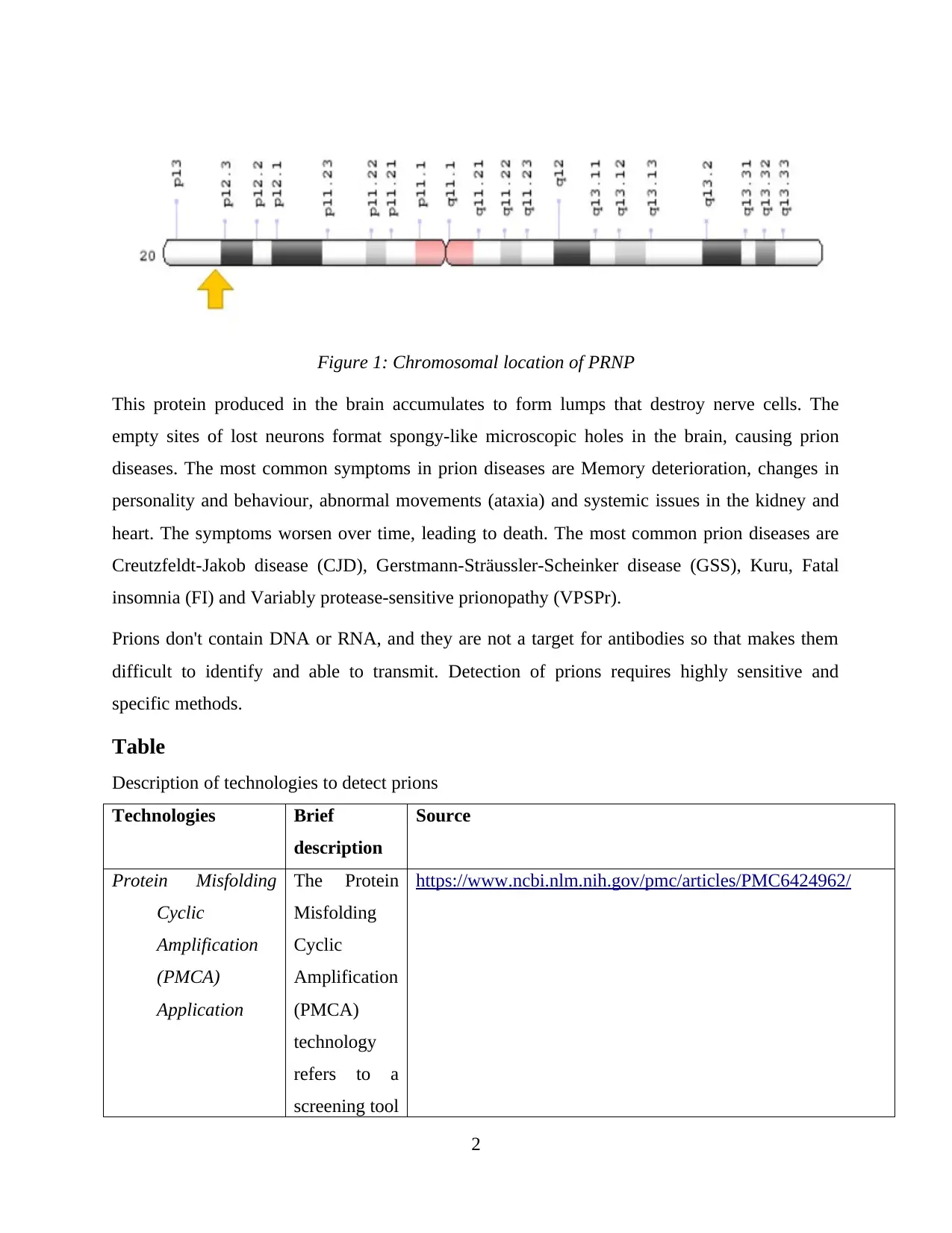
Figure 1: Chromosomal location of PRNP
This protein produced in the brain accumulates to form lumps that destroy nerve cells. The
empty sites of lost neurons format spongy-like microscopic holes in the brain, causing prion
diseases. The most common symptoms in prion diseases are Memory deterioration, changes in
personality and behaviour, abnormal movements (ataxia) and systemic issues in the kidney and
heart. The symptoms worsen over time, leading to death. The most common prion diseases are
Creutzfeldt-Jakob disease (CJD), Gerstmann-Sträussler-Scheinker disease (GSS), Kuru, Fatal
insomnia (FI) and Variably protease-sensitive prionopathy (VPSPr).
Prions don't contain DNA or RNA, and they are not a target for antibodies so that makes them
difficult to identify and able to transmit. Detection of prions requires highly sensitive and
specific methods.
Table
Description of technologies to detect prions
Technologies Brief
description
Source
Protein Misfolding
Cyclic
Amplification
(PMCA)
Application
The Protein
Misfolding
Cyclic
Amplification
(PMCA)
technology
refers to a
screening tool
https://www.ncbi.nlm.nih.gov/pmc/articles/PMC6424962/
2
This protein produced in the brain accumulates to form lumps that destroy nerve cells. The
empty sites of lost neurons format spongy-like microscopic holes in the brain, causing prion
diseases. The most common symptoms in prion diseases are Memory deterioration, changes in
personality and behaviour, abnormal movements (ataxia) and systemic issues in the kidney and
heart. The symptoms worsen over time, leading to death. The most common prion diseases are
Creutzfeldt-Jakob disease (CJD), Gerstmann-Sträussler-Scheinker disease (GSS), Kuru, Fatal
insomnia (FI) and Variably protease-sensitive prionopathy (VPSPr).
Prions don't contain DNA or RNA, and they are not a target for antibodies so that makes them
difficult to identify and able to transmit. Detection of prions requires highly sensitive and
specific methods.
Table
Description of technologies to detect prions
Technologies Brief
description
Source
Protein Misfolding
Cyclic
Amplification
(PMCA)
Application
The Protein
Misfolding
Cyclic
Amplification
(PMCA)
technology
refers to a
screening tool
https://www.ncbi.nlm.nih.gov/pmc/articles/PMC6424962/
2

that is used to
detect the
presence of
bovine (BSE)
and human
(vCJD)
prions within
a human cell
therapy. It is
highly
efficient in
identifying
and
amplifying a
small amount
of PRPSc
present in a
blood or
urine sample
Immunohistochemical
Detection
A technique
Depends on
detection of
PRPSc in
lymphoid
tissues such
as spleen,
palatine
tonsils and
lymph nodes
by
Inoculating
https://jcm.asm.org/content/34/5/1228.short
3
detect the
presence of
bovine (BSE)
and human
(vCJD)
prions within
a human cell
therapy. It is
highly
efficient in
identifying
and
amplifying a
small amount
of PRPSc
present in a
blood or
urine sample
Immunohistochemical
Detection
A technique
Depends on
detection of
PRPSc in
lymphoid
tissues such
as spleen,
palatine
tonsils and
lymph nodes
by
Inoculating
https://jcm.asm.org/content/34/5/1228.short
3
⊘ This is a preview!⊘
Do you want full access?
Subscribe today to unlock all pages.

Trusted by 1+ million students worldwide

tissue
samples with
anti-peptides
directed
against prions
and synthesis
specific
peptides and
anti-peptide
antisera. IMC
test is used to
detect anti-
peptide
antisera in the
lymphoid
tissues thus
detecting the
prions.
Enzyme-linked
immunosorbent
assay (ELISA)
This
technology
has proven its
high
sensitivity
and
specificity to
detect PrPSc
in brain and
lymphoid
tissues. The
assay is rapid
and reliable
https://onlinelibrary.wiley.com/doi/abs/10.1002/path.1294
4
samples with
anti-peptides
directed
against prions
and synthesis
specific
peptides and
anti-peptide
antisera. IMC
test is used to
detect anti-
peptide
antisera in the
lymphoid
tissues thus
detecting the
prions.
Enzyme-linked
immunosorbent
assay (ELISA)
This
technology
has proven its
high
sensitivity
and
specificity to
detect PrPSc
in brain and
lymphoid
tissues. The
assay is rapid
and reliable
https://onlinelibrary.wiley.com/doi/abs/10.1002/path.1294
4
Paraphrase This Document
Need a fresh take? Get an instant paraphrase of this document with our AI Paraphraser

for human
diagnostic
purposes.
When the
ELISA plate
is coated with
MAb 11G5,
it will
effectively
capture the
PrP species
and then the
PRPSc can be
distinguished
using
different anti-
PrP MAb.
The Real-Time
Quaking-Induced
Conversion (RT-
QuIC) assay
It is the most
sensitive and
specific assay
to detect the
prion with up
to 97%
sensitivity
and 100%
specificity.
RT-QuiC is
promising
and reliable
as a
diagnostic
https://www.hindawi.com/journals/bmri/2017/5413936/
5
diagnostic
purposes.
When the
ELISA plate
is coated with
MAb 11G5,
it will
effectively
capture the
PrP species
and then the
PRPSc can be
distinguished
using
different anti-
PrP MAb.
The Real-Time
Quaking-Induced
Conversion (RT-
QuIC) assay
It is the most
sensitive and
specific assay
to detect the
prion with up
to 97%
sensitivity
and 100%
specificity.
RT-QuiC is
promising
and reliable
as a
diagnostic
https://www.hindawi.com/journals/bmri/2017/5413936/
5

procedure for
genetic prion
human
diseases.
Streptomycin
detection
The ability of
streptomycin
for forming
the multi-
molecular
aggregates
with PrP i.e.
pathogenic
prion proteins
including
recovery of
the same, by
precipitation
through a
low-speed
centrifugation
step can be
demonstrated.
Such novel
properties of
the
streptomycin
make the
same as a
useful
substance,
which results
https://www.semanticscholar.org/paper/Rapid-diagnosis-of-
human-prion-disease-using-with-Quadrio-Ugnon-Caf
%C3%A9/44ba7d8b1de9213a04457df86226f53533cb1730
6
genetic prion
human
diseases.
Streptomycin
detection
The ability of
streptomycin
for forming
the multi-
molecular
aggregates
with PrP i.e.
pathogenic
prion proteins
including
recovery of
the same, by
precipitation
through a
low-speed
centrifugation
step can be
demonstrated.
Such novel
properties of
the
streptomycin
make the
same as a
useful
substance,
which results
https://www.semanticscholar.org/paper/Rapid-diagnosis-of-
human-prion-disease-using-with-Quadrio-Ugnon-Caf
%C3%A9/44ba7d8b1de9213a04457df86226f53533cb1730
6
⊘ This is a preview!⊘
Do you want full access?
Subscribe today to unlock all pages.

Trusted by 1+ million students worldwide
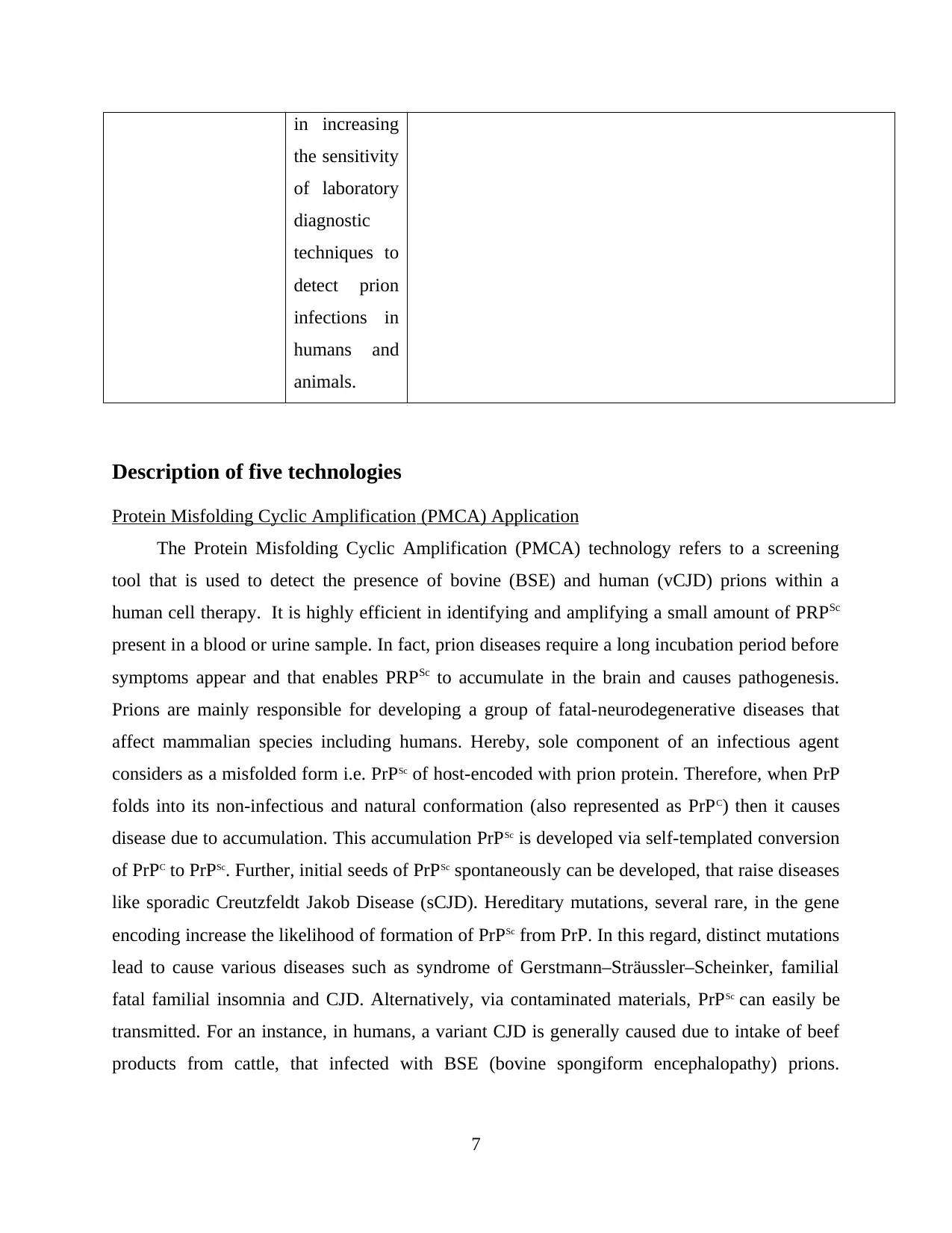
in increasing
the sensitivity
of laboratory
diagnostic
techniques to
detect prion
infections in
humans and
animals.
Description of five technologies
Protein Misfolding Cyclic Amplification (PMCA) Application
The Protein Misfolding Cyclic Amplification (PMCA) technology refers to a screening
tool that is used to detect the presence of bovine (BSE) and human (vCJD) prions within a
human cell therapy. It is highly efficient in identifying and amplifying a small amount of PRPSc
present in a blood or urine sample. In fact, prion diseases require a long incubation period before
symptoms appear and that enables PRPSc to accumulate in the brain and causes pathogenesis.
Prions are mainly responsible for developing a group of fatal-neurodegenerative diseases that
affect mammalian species including humans. Hereby, sole component of an infectious agent
considers as a misfolded form i.e. PrPSc of host-encoded with prion protein. Therefore, when PrP
folds into its non-infectious and natural conformation (also represented as PrPC) then it causes
disease due to accumulation. This accumulation PrPSc is developed via self-templated conversion
of PrPC to PrPSc. Further, initial seeds of PrPSc spontaneously can be developed, that raise diseases
like sporadic Creutzfeldt Jakob Disease (sCJD). Hereditary mutations, several rare, in the gene
encoding increase the likelihood of formation of PrPSc from PrP. In this regard, distinct mutations
lead to cause various diseases such as syndrome of Gerstmann–Sträussler–Scheinker, familial
fatal familial insomnia and CJD. Alternatively, via contaminated materials, PrPSc can easily be
transmitted. For an instance, in humans, a variant CJD is generally caused due to intake of beef
products from cattle, that infected with BSE (bovine spongiform encephalopathy) prions.
7
the sensitivity
of laboratory
diagnostic
techniques to
detect prion
infections in
humans and
animals.
Description of five technologies
Protein Misfolding Cyclic Amplification (PMCA) Application
The Protein Misfolding Cyclic Amplification (PMCA) technology refers to a screening
tool that is used to detect the presence of bovine (BSE) and human (vCJD) prions within a
human cell therapy. It is highly efficient in identifying and amplifying a small amount of PRPSc
present in a blood or urine sample. In fact, prion diseases require a long incubation period before
symptoms appear and that enables PRPSc to accumulate in the brain and causes pathogenesis.
Prions are mainly responsible for developing a group of fatal-neurodegenerative diseases that
affect mammalian species including humans. Hereby, sole component of an infectious agent
considers as a misfolded form i.e. PrPSc of host-encoded with prion protein. Therefore, when PrP
folds into its non-infectious and natural conformation (also represented as PrPC) then it causes
disease due to accumulation. This accumulation PrPSc is developed via self-templated conversion
of PrPC to PrPSc. Further, initial seeds of PrPSc spontaneously can be developed, that raise diseases
like sporadic Creutzfeldt Jakob Disease (sCJD). Hereditary mutations, several rare, in the gene
encoding increase the likelihood of formation of PrPSc from PrP. In this regard, distinct mutations
lead to cause various diseases such as syndrome of Gerstmann–Sträussler–Scheinker, familial
fatal familial insomnia and CJD. Alternatively, via contaminated materials, PrPSc can easily be
transmitted. For an instance, in humans, a variant CJD is generally caused due to intake of beef
products from cattle, that infected with BSE (bovine spongiform encephalopathy) prions.
7
Paraphrase This Document
Need a fresh take? Get an instant paraphrase of this document with our AI Paraphraser
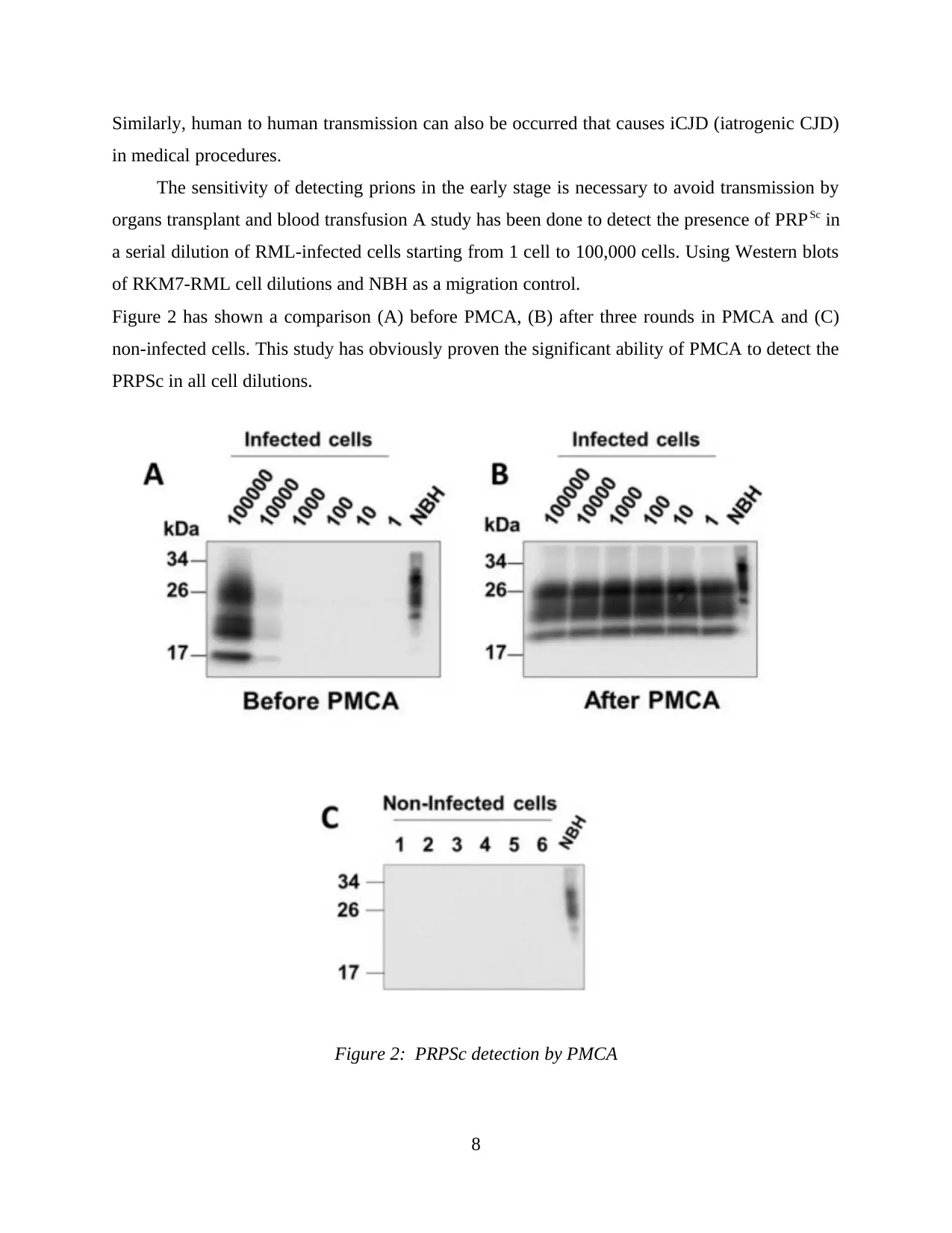
Similarly, human to human transmission can also be occurred that causes iCJD (iatrogenic CJD)
in medical procedures.
The sensitivity of detecting prions in the early stage is necessary to avoid transmission by
organs transplant and blood transfusion A study has been done to detect the presence of PRPSc in
a serial dilution of RML-infected cells starting from 1 cell to 100,000 cells. Using Western blots
of RKM7-RML cell dilutions and NBH as a migration control.
Figure 2 has shown a comparison (A) before PMCA, (B) after three rounds in PMCA and (C)
non-infected cells. This study has obviously proven the significant ability of PMCA to detect the
PRPSc in all cell dilutions.
Figure 2: PRPSc detection by PMCA
8
in medical procedures.
The sensitivity of detecting prions in the early stage is necessary to avoid transmission by
organs transplant and blood transfusion A study has been done to detect the presence of PRPSc in
a serial dilution of RML-infected cells starting from 1 cell to 100,000 cells. Using Western blots
of RKM7-RML cell dilutions and NBH as a migration control.
Figure 2 has shown a comparison (A) before PMCA, (B) after three rounds in PMCA and (C)
non-infected cells. This study has obviously proven the significant ability of PMCA to detect the
PRPSc in all cell dilutions.
Figure 2: PRPSc detection by PMCA
8
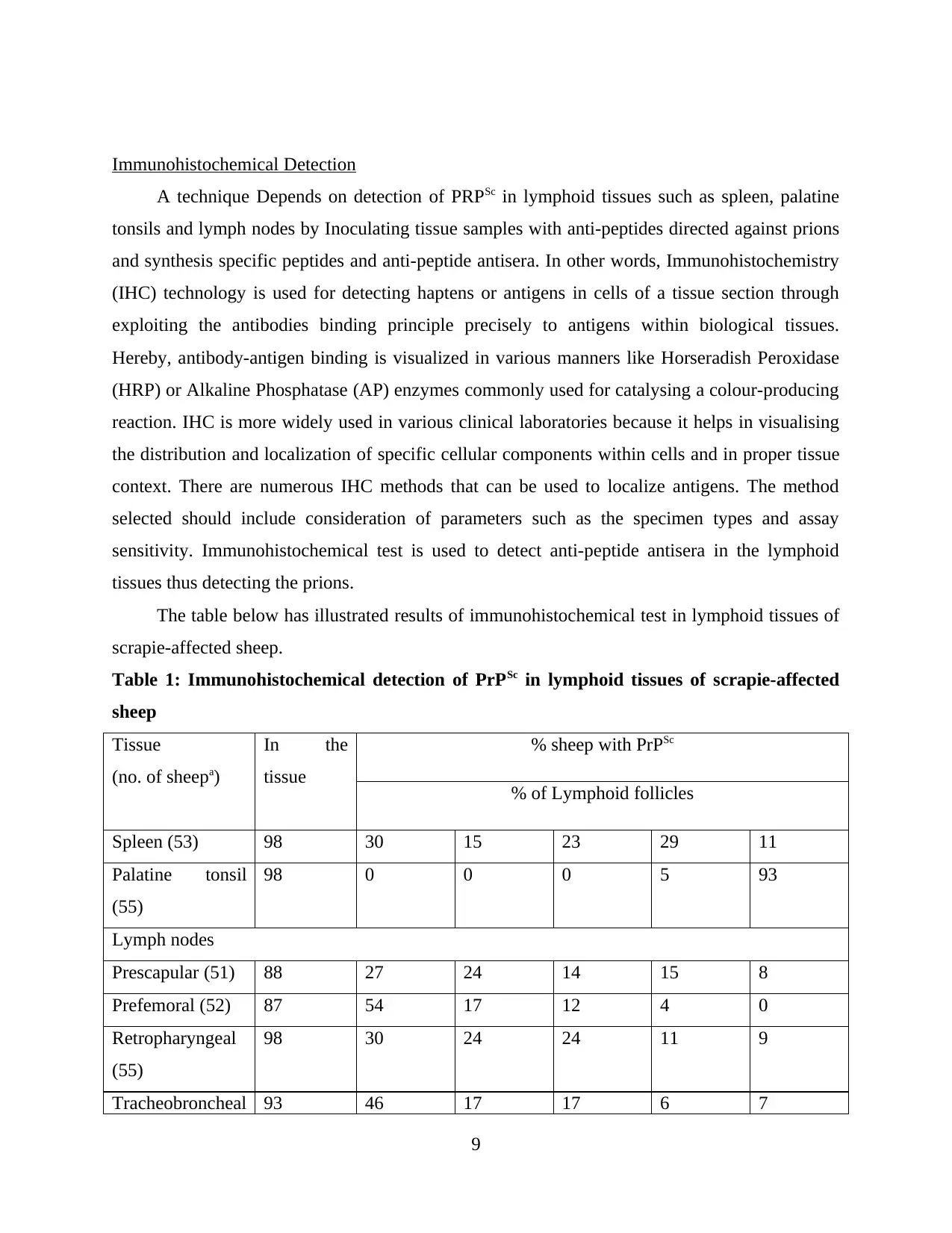
Immunohistochemical Detection
A technique Depends on detection of PRPSc in lymphoid tissues such as spleen, palatine
tonsils and lymph nodes by Inoculating tissue samples with anti-peptides directed against prions
and synthesis specific peptides and anti-peptide antisera. In other words, Immunohistochemistry
(IHC) technology is used for detecting haptens or antigens in cells of a tissue section through
exploiting the antibodies binding principle precisely to antigens within biological tissues.
Hereby, antibody-antigen binding is visualized in various manners like Horseradish Peroxidase
(HRP) or Alkaline Phosphatase (AP) enzymes commonly used for catalysing a colour-producing
reaction. IHC is more widely used in various clinical laboratories because it helps in visualising
the distribution and localization of specific cellular components within cells and in proper tissue
context. There are numerous IHC methods that can be used to localize antigens. The method
selected should include consideration of parameters such as the specimen types and assay
sensitivity. Immunohistochemical test is used to detect anti-peptide antisera in the lymphoid
tissues thus detecting the prions.
The table below has illustrated results of immunohistochemical test in lymphoid tissues of
scrapie-affected sheep.
Table 1: Immunohistochemical detection of PrPSc in lymphoid tissues of scrapie-affected
sheep
Tissue
(no. of sheepa)
In the
tissue
% sheep with PrPSc
% of Lymphoid follicles
Spleen (53) 98 30 15 23 29 11
Palatine tonsil
(55)
98 0 0 0 5 93
Lymph nodes
Prescapular (51) 88 27 24 14 15 8
Prefemoral (52) 87 54 17 12 4 0
Retropharyngeal
(55)
98 30 24 24 11 9
Tracheobroncheal 93 46 17 17 6 7
9
A technique Depends on detection of PRPSc in lymphoid tissues such as spleen, palatine
tonsils and lymph nodes by Inoculating tissue samples with anti-peptides directed against prions
and synthesis specific peptides and anti-peptide antisera. In other words, Immunohistochemistry
(IHC) technology is used for detecting haptens or antigens in cells of a tissue section through
exploiting the antibodies binding principle precisely to antigens within biological tissues.
Hereby, antibody-antigen binding is visualized in various manners like Horseradish Peroxidase
(HRP) or Alkaline Phosphatase (AP) enzymes commonly used for catalysing a colour-producing
reaction. IHC is more widely used in various clinical laboratories because it helps in visualising
the distribution and localization of specific cellular components within cells and in proper tissue
context. There are numerous IHC methods that can be used to localize antigens. The method
selected should include consideration of parameters such as the specimen types and assay
sensitivity. Immunohistochemical test is used to detect anti-peptide antisera in the lymphoid
tissues thus detecting the prions.
The table below has illustrated results of immunohistochemical test in lymphoid tissues of
scrapie-affected sheep.
Table 1: Immunohistochemical detection of PrPSc in lymphoid tissues of scrapie-affected
sheep
Tissue
(no. of sheepa)
In the
tissue
% sheep with PrPSc
% of Lymphoid follicles
Spleen (53) 98 30 15 23 29 11
Palatine tonsil
(55)
98 0 0 0 5 93
Lymph nodes
Prescapular (51) 88 27 24 14 15 8
Prefemoral (52) 87 54 17 12 4 0
Retropharyngeal
(55)
98 30 24 24 11 9
Tracheobroncheal 93 46 17 17 6 7
9
⊘ This is a preview!⊘
Do you want full access?
Subscribe today to unlock all pages.

Trusted by 1+ million students worldwide
1 out of 17
Related Documents
Your All-in-One AI-Powered Toolkit for Academic Success.
+13062052269
info@desklib.com
Available 24*7 on WhatsApp / Email
![[object Object]](/_next/static/media/star-bottom.7253800d.svg)
Unlock your academic potential
Copyright © 2020–2025 A2Z Services. All Rights Reserved. Developed and managed by ZUCOL.



